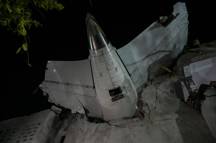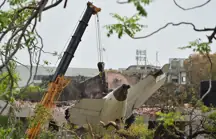A new theory has emerged in the aftermath of the Air India Flight AI171 disaster, as a leading aviation analyst reversed his original explanation after reviewing footage of the tragedy.
The crash - which remains one of the deadliest aviation tragedies in India's history - has resulted in the deaths of 279 people, with 241 of the 242 onboard the plane losing their lives.
Disaster Unfolds Seconds After Takeoff
Flight AI171, bound for London Gatwick, took off from Ahmedabad on June 12, 2025, and plummeted to the ground within seconds. The aircraft exploded into a fireball after crashing into a residential area, killing 241 people onboard and at least 38 on the ground. The total death toll currently stands at 279, according to the Daily Mail.
Vishwash Kumar Ramesh, who had been sitting in seat 11A, was the only passenger to miraculously survive the crash. Though his brother Ajay Kumar, seated across the aisle in 11J, perished in the tragedy.
Investigators from India’s Aircraft Accident Investigation Bureau (AAIB) have since recovered both of the jet’s black boxes. The AAIB is leading the probe, with help from experts in the US and UK, as families in India and abroad await answers.
High-Definition Footage Flips the Script
Captain Steve Schreiber, a seasoned commercial airline pilot and YouTuber known for dissecting plane crashes, initially speculated that a simple cockpit blunder caused the crash, thinking the co-pilot mistakenly extended the wing flaps instead of retracting the landing gear.

But after reviewing a newly released, high-definition video of the Boeing 787 Dreamliner’s final moments, his theory has taken a dramatic turn.
“This is a total gamechanger,” Schreiber told his audience, per News.com.au.
The clearer footage reveals a small but critical detail — a “little grey dot” beneath the aircraft’s right wing. According to Schreiber, that dot indicates that the Ram Air Turbine (RAT) had deployed mid-flight.
“Many aeroplanes have it,” he explained. “It is just behind the wing on the right side of the aeroplane, there is a little door that holds it in. It looks like a little Evinrude motor, it’s a little two bladed prop. The purpose of the Ram Air Turbine is to provide electrical and hydraulic pressure for the aircraft in an extreme emergency.”
RAT Deployment Points to Potential 'Engine Failure'
Schreiber went on to say that on a Boeing 787, there are only three extreme emergencies that could trigger RAT deployment: “A massive electrical failure, a massive hydraulic failure, or a dual engine failure.”
“That little grey dot is the RAT,” he confirmed. “This video is visual confirmation that the RAT deployed. The protrusion is the door that opened to allow the RAT to come down.”
In the new footage, Schreiber also picked up on the telltale sound of the RAT — a high-pitched whine that resembles a propeller plane whizzing by.
“A RAT makes a distinctive sound, it sounds like a propeller aeroplane going by, or a real high-pitched squeal,” he said. “It is basically spinning at the speed of sound to produce the energy, electrical and hydraulic that it needs to. If you weren’t looking at it, it sounded like a single-engine prop aeroplane just flew by.”
He emphasized that while the RAT is meant to be a last-resort backup at high altitudes, the fact that it deployed at just 400 to 500 feet is telling.
“It is not designed for an aeroplane at 400–500ft. But it is evidence for us,” he said. “It is evidence for us it was dual engine failure, most likely.”
Sole Survivor Speak Out: “It Felt Like It Was Stuck in the Air”
Adding weight to Schreiber’s theory is the harrowing account of the crash’s sole survivor, 40-year-old British national Vishwash Kumar Ramesh.

From his hospital bed, Ramesh recalled, per the Daily Mail: “When the flight took off, within five to 10 seconds it felt like it was stuck in the air. Suddenly, the lights started flickering – green and white. The aircraft wasn’t gaining altitude and was just gliding before it suddenly slammed into a building and exploded.”
Schreiber believes the flickering lights and sudden loss of altitude described by Ramesh line up with the symptoms of RAT deployment, further suggesting a complete loss of engine power.
“We have got a guy saying he heard a loud bang and the lights flickered, what would cause that? The deployment of the RAT. It’s going to take over electrical and hydraulic and as it does that the lights in the aeroplane would flicker," the YouTuber said.
He added: “I have heard reports the captain got out a mayday call and he said they were losing thrust. That could be the fourth piece of evidence for dual engine failure.”
Hero Pilot Diverts Plane at Last Second
Captain Sumeet Sabharwal, the 55-year-old pilot of the ill-fated Dreamliner, has been hailed a hero after it is believed that he deliberately diverted the aircraft away from an apartment block just before impact, likely preventing the death toll from soaring higher.
Eyewitnesses reported that the plane narrowly missed residential buildings and instead collided with a building that was used as doctors' accommodation at the BJ Medical College and Civil Hospital, per BBC News.
Parts of the fuselage and landing gear were later found embedded in the side of the hospital’s canteen, still surrounded by half-eaten plates of food.
Despite Captain Steve’s confidence in the dual engine failure theory, some aviation experts have been more cautious. Consultant Keith Tonkin previously commented, per News.com.au: “Whether it’s to do with the engines or some other equipment on the aircraft, it’s not really obvious at the moment.”
He added: “There’s a little, little moment in time somewhere between taking off and somewhere in that very short climb out where something horrible is happening that the pilots weren’t able to manage.”

The Aftermath
DNA testing is underway to formally identify the victims, with more than 30 matches already made.
Vigils have been held across both India and the UK, including outside the Indian High Commission in London, where candles were lit in memory of those who perished.
India’s civil aviation minister has confirmed that the black boxes will “significantly aid the inquiry.” Meanwhile, safety inspections have been ordered across Air India’s entire Boeing 787-8 and 787-9 fleets.
Air India CEO Campbell Wilson has also revealed that the airline, along with its parent company Tata Sons, will provide over ₹1.25 crore (approximately £106,000 or $133,000) to the families of each deceased passenger and the survivor.
The tragedy has left the world searching for answers, with Captain Steve’s revised theory now at the forefront of the conversation — backed by a growing list of video, audio, and eyewitness evidence.
